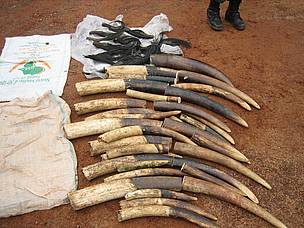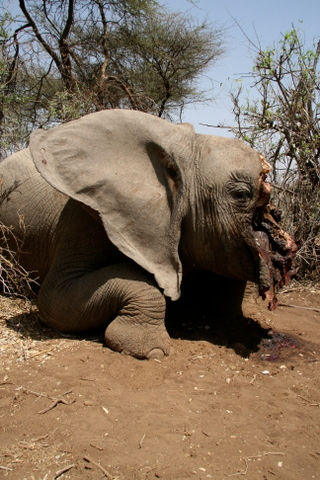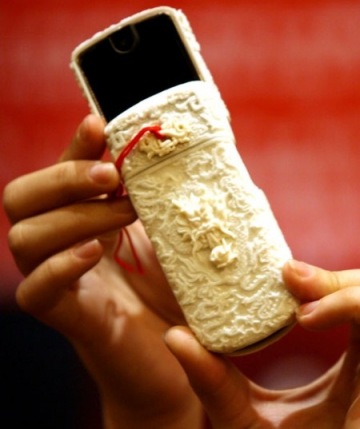Elephants still poached for asian trinkets
Monday, August 29th, 2011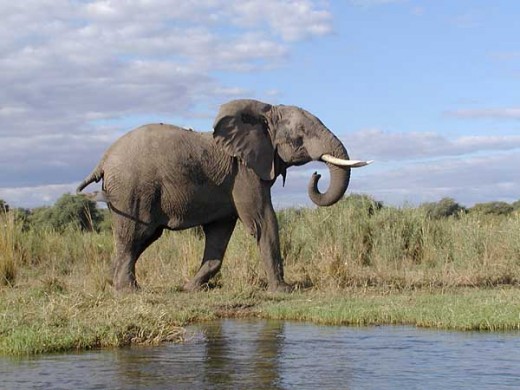 The magnificent African Bush Elephant bull (male) walking tall in its native savannah homeland
The magnificent African Bush Elephant bull (male) walking tall in its native savannah homeland
.
Out of Victorian colonial exploits of the 19th Century, elephant tusks could be found butchered and refined into expensive goods, notably billiard balls, piano keys, Scottish bagpipes, garment buttons, letter openers and for many ornamental items otherwise considered mere ‘trinkets’.
After the elephant tusk (‘ivory’) trade had decimated the African Elephant population from 1.3 million to 625,000, finally in 1989 the Environmental Investigation Agency (EIA) imposed a ban on this international elephant tusk (ivory) trade.
Ten years on, Zimbabwean dictator, Robert Mugabe, lifted the ban along with Botswana, Namibia, and South Africa and legalised the sale of elephant tusks from elephants they claimed (a) had died naturally or (b) been shot because they were violently aggressive or for ‘problem-animal’ control. In 1999, the Convention on International Trade in Endangered Species of Wild Fauna and Flora (CITES) authorized an auction of 50 tons of elephant tusks (ivory) from these four countries to the value of USD$5 million. Notably, the demand for elephant has been driven outside the African continent, in this episode mainly by Japan.
One could find a comparable solution for controlling Robert Mugabe…
 Tool of the Willing
(for just one day hire, …’our troubles there would be over very quickly’.)
~ borrowed from Colonel Walter E. Kurtz.
Tool of the Willing
(for just one day hire, …’our troubles there would be over very quickly’.)
~ borrowed from Colonel Walter E. Kurtz.
.
In 2008, China was also given permission to become a licensed buyer of elephant tusks (ivory) and this followed 108 tons of elephant tusks (ivory) being auctioned from these same four African countries, representing the death of over 10,000 African elephants.
.
“The growing demand for elephant tusks (ivory) has increased black market prices from $200 per kilo to $850 per kilo in the past four years thus creating a big financial incentive for poachers. Michael Wamithi, program director for International Fund for Animal Welfare’s global elephants program, and former director of the Kenya Wildlife Service, declared: “An estimated 20,000 elephants are slaughtered annually for the trade in their tusks. Many African elephant range states clearly do not have the capacity or resources to combat these massive attacks on their countries’ wildlife heritage and the burgeoning markets in China are only fuelling these attacks.”
.
The Environmental Investigation Agency (EIA), which exposes environmental crimes, said CITES had ignored appeals from other African nations not to increase pressures on their elephant populations which were already struggling with wars, instability, droughts and poverty. EIA chairman Allan Thornton said:
“Responsibility for the poaching of 20,000 elephants in Africa each year will now lie with those who supported China obtaining legal ivory trade even though they continue to be the world’s biggest destination for poached ivory.”
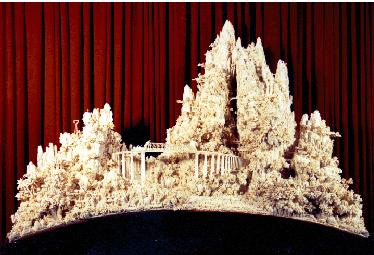 This elephant tusk (ivory) carving (photo) is a gift from China presented to the United Nations in 1974.
It depicts the Chengtu-Kunming railway, which was opened to traffic in 1970.
The sculpture was carved from eight elephant tusks. In elephant terms, four mature bull elephants were killed for this elaborate trinket.
This elephant tusk (ivory) carving (photo) is a gift from China presented to the United Nations in 1974.
It depicts the Chengtu-Kunming railway, which was opened to traffic in 1970.
The sculpture was carved from eight elephant tusks. In elephant terms, four mature bull elephants were killed for this elaborate trinket.One wonders whether the United Nations is still pleased with its eight bull elephant tusk trophy (shot and hacked off from a bull elephant like that above)?
.
.
Chinese, Japanese and Thais still Elephant Poaching in Africa
.
China and Japan bought 108 tonnes of ivory in another “one-off” sale in November 2008 from Botswana, South Africa, Namibia and Zimbabwe. At the time the idea was that these legal ivory sales may depress the price, thereby removing poaching pressure, an idea supported by both Traffic and WWF.
China’s increased involvement in infrastructure projects in Africa and the purchase of natural resources has alarmed many conservationists who fear the extraction of wildlife body parts is increasing. Since China was given “approved buyer” status by CITES, the smuggling of ivory seems to have increased alarmingly. Although, WWF and Traffic who supported the China sale, describe the increase in illegal ivory trade a possible “coincidence” others are less cautious. Chinese nationals working in Africa have been caught smuggling ivory in many African countries, with at least ten arrested at Kenyan airports in 2009. In many African countries domestic markets have grown, providing easy access to ivory, although the Asian ivory syndicates are most destructive buying and shipping tonnes at a time.
Contrary to the advice of CITES that prices may be depressed, and those that supported the sale of stockpiles in 2008, the price of ivory in China has greatly increased. Some believe this may be due to deliberate price fixing by those who bought the stockpile, echoing the warnings from the Japan Wildlife Conservation Society on price-fixing after sales to Japan in 1997, and monopoly given to traders who bought stockpiles from Burundi and Singapore in the 1980s. It may also be due to the exploding number of Chinese able to purchase luxury goods.
Despite arguments prevailing on the ivory trade for the last thirty years through CITES, there is one fact that virtually all informed parties now agree upon: poaching of African elephants is now seriously on the increase.’
.
.
‘Shopping habits of China’s ‘suddenly wealthy’
[Source: by Rose Gamble, freelance journalist, FT.com, 20090821, ^http://www.ft.com/cms/s/2/9271a266-8d21-11de-a540-00144feabdc0.html#ixzz1WPkaKde6, accessed 20110829]
.
Ivory:
‘For more than 7,000 years, Chinese artisans have been crafting elephant ivory. Favoured by the Imperial household as far back as the Qing dynasty (1680), ivory has an illustrious reputation and an association with the wealthy and elite. But in 1989, the trading of ivory was banned worldwide through the Convention on International Trade in Endangered Species (Cites), after more than half of Africa’s 1.3 million elephants were poached in a single decade. And yet, with a carving trade established in antiquity and a burgeoning middle class who, for the first time, can afford to buy ivory, China remains its biggest importer.
As Asian elephant herds dwindle, African elephants have become the only source of ivory.
In late 2008, Cites authorities allowed China to bid with Japan for tusks from official stockpiles – consisting of ivory collected from elephants that had died a natural death – in four southern African countries. In an open declaration of a continuing demand, 12 Chinese traders bought 62 tonnes at an average price of $144 per kilo. Since this legal purchase, more than 11 tonnes of illegal African ivory have been impounded en route to China.
Elephant poaching largely takes place in central Africa, where poverty and political instability are rife. Chronic unemployment, the availability of firearms and corruption all facilitate the illegal ivory trade. These regions are also home to unregulated domestic ivory markets, where carved items are bought and sold. According to ivory expert Esmond Martin, the majority of buyers are Chinese. In a scramble for Africa’s minerals and resources, the continent has seen a recent influx of Chinese workers – a presence that is visibly reflected in the illegal retailing of ivory. On a recent trip to Addis Ababa, Ethiopia, Martin recorded 1,433 items of ivory openly displayed in the city’s main streets and central market. Among these were 149 pairs of freshly carved ivory chopsticks, selling for $16 each – in sharp contrast to a Chinese retail price of $139 – and signature stamps and jewellery. All of these items were small enough to potentially smuggle through customs.
Martin had previously estimated that 4,900 to 12,000 elephants from central Africa were killed each year to supply tusks to the craftsmen of Africa, China and Thailand.
Conservationists are deeply concerned. According to Barbara Maas, CEO of Care for the Wild International: “With the number of Chinese nationals resident in Africa rising, and poaching on the increase, the frontline between supply and demand for ivory is now perilously close, with a disastrous outcome for elephants.”
.
..
‘Campaigners’ fear for elephants, and their own credibility’
[Source: The Economist, 20080717, ^http://www.economist.com/node/11751304 ].
‘Nobody can deny that China’s black market was rampant until recently. In a report to the UN leaked by the Environmental Investigation Agency (EIA), a campaigning group, this month, Chinese officials admitted that between 1991 and 2002 they had lost sight of 121 tonnes of ivory, the equivalent of the tusks from 11,000 elephants.
Is China observing the CITES rules now? A brief visit to China in 2007 by inspectors from the CITES secretariat suggested that things had improved: they said that ivory was becoming harder to find, though they came across a shop in the city of Xi’an with ivory carvings of dubious provenance. A bigger investigation was carried out by TRAFFIC, an independent British-based group that monitors wildlife trade. After studying 10,000 shops between 2006 and 2008, it reported a progressive decline in the availability of illegal ivory. This had coincided with greater police vigilance.
The idea that China is cleaning up its act got another boost in March, when over 750kg (1,650lb) of raw ivory was seized in Guangxi Province. As CITES notes, the penalties for illegal trading include life imprisonment and death. But the EIA, which uses undercover methods to probe the trade, says things are not as good as they seem; in 2007 its researchers found a roomful of illegal ivory, including an uncut tusk, for sale in the city of Dalian. Last month they made a small find in Gansu province.
A more interesting question is how the legal sales now in prospect will affect the black market. A fresh supply of legal ivory may depress the price, and reduce the incentive to poach. TRAFFIC notes that after a legal auction in 1999, the price fell; this led to a decline in poaching over five years. For doctrinaire types, who oppose all trade in ivory, the forthcoming sale is not just a challenge to endangered animals; it could be a threat to the credibility of their best-loved arguments.’
.
.
‘Data shows illegal ivory trade on rise’
[Source: World Wildlife Fund (WWF), Cambridge, UK, 20091116, ^http://wwf.panda.org/wwf_news/?uNewsID=180702, accessed 20110829]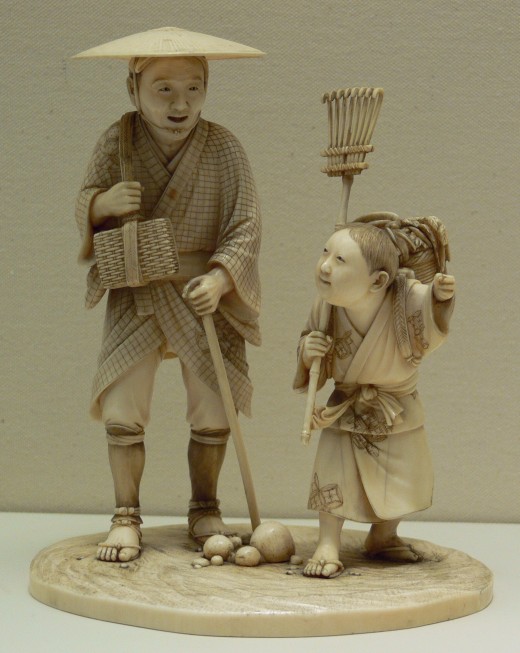
.
‘The illicit trade in ivory, which has been increasing in volume since 2004, moved sharply upward in 2009, according to the latest analysis of seizure data in the Elephant Trade Information System (ETIS).
ETIS, one of the two monitoring systems for elephants under CITES (the Convention on International Trade in Endangered Species of Wild Fauna and Flora) but managed by TRAFFIC, holds the world’s largest collection of elephant product seizure records.
The analysis, undertaken in advance of the 15th meeting of the Conference of the Parties (CoP15) to CITES, was based upon 14,364 elephant product seizure records from 85 countries or territories since 1989, nearly 2,000 more records than the previous analysis, in 2007.
The remarkable surge in 2009 reflects a series of large-scale ivory seizure events that suggest increased involvement of organized crime syndicates in the trade, connecting African source countries with Asian end-use markets. The ETIS data indicate that such syndicates have become stronger and more active over the last decade.
There continues to be a highly significant correlation between large-scale domestic ivory markets in Asia and Africa and poor law enforcement, suggesting that illicit ivory trade flows typically follow a path to destinations where law enforcement is weak and markets function with little regulatory impediment.
Indeed, the rise in illicit trade in ivory indicates that implementation of a CITES “action plan for the control of trade in African elephant ivory,” the Convention’s principal vehicle for closing such unregulated and illicit domestic markets in Africa and Asia, has failed to drive any significant change over the last five years.
The ETIS analysis identifies Nigeria, the Democratic Republic of the Congo and Thailand as the three countries most heavily implicated in the global illicit ivory trade. Illegal trade involving each of these nations has been repeatedly singled out for priority attention since the first assessment in 2002, but they continue to feature as critical hotspots in the trade as sources, entrêpots and consumers of ivory.
Another nine countries and territories—Cameroon, Gabon and Mozambique in Africa and Hong Kong SAR, Malaysia, the Philippines, Singapore, Taiwan and Vietnam in Asia—were also identified as important nodes in the illicit ivory trade.
China, which along with Japan was an approved destination of the legal, CITES-sanctioned one-off ivory sale in 2008, faces a persistent illegal trade challenge from Chinese nationals now based in Africa. Ongoing evidence highlights widespread involvement of overseas Chinese in the illicit procurement of ivory, a problem that needs to be addressed through an aggressive outreach and awareness initiative directed at Chinese communities living abroad.
The results are less clear-cut concerning the impacts of the CITES approved one-off ivory sales in 1999 and 2008.
Following the first such sale, in June 1999, there was a progressive decline in the illicit trade in ivory for five years, with no evidence to suggest that the sale had resulted in an increase in the illicit ivory trade globally.
After the second CITES-approved ivory sale, in late 2008, the results are unclear as to whether it has stimulated increase demand or whether it has simply coincided with an increase in supply that was already underway over the last four years. The collection of more data over an extended time period will throw further light on this vital issue.’
.
The full ETIS report can be downloaded from the CITES website as document at ^http://www.cites.org/common/cop/15/doc/E15-44-01A.pdf
.
.
‘China Fuels East African Elephant Poaching’
[Source: Damian Robin, Epoch Times, 20100330, ^http://www.theepochtimes.com/n2/content/view/32389/, accessed 20110829]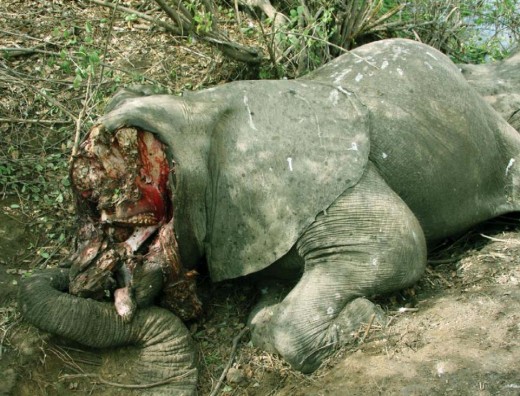
.
China’s influence in East Africa is fueling an upsurge in elephant poaching, gunrunning, and corruption according to a report on U.K. television Friday. A Channel 4 reporter spoke to people in villages and cities, wildlife managers, rangers, government officials, and illegal ivory sellers in Kenya and Tanzania—all of whom said China is the main buyer of banned ivory.
Filmed secretly, sellers told the journalist from Unreported World that during a presidential visit from Chinese Communist Party leader Hu Jintao in 2009, two hundred kilos of ivory was bought by Chinese diplomats and taken out of Tanzania.
The sellers did not say if Hu knew of the trade, but did say that a prominent diplomat from the Chinese Embassy frequently bought large amounts of ivory from them.
Kooky Gorman owns a wildlife park in Kenya. Accompanied by armed rangers, she took the reporter to many spots in her park, where elephant carcasses rotted, their heads split open to make it easy to saw the tusks off.
Many hides showed multiple bullet holes. The lead ranger said the killers had used AK47 automatic weapons to spray herds. The shootings were indiscriminate, killing young and old.
Gorman said the weapons were bought from neighboring Somalia where the civil war has continued since 1991.
The intensity of the poaching has been increasing for the past two years. In 2007 six elephants were poached from her park. In 2008, twenty-eight were poached. Fifty-seven were poached in 2009.
She says there is a threat of elephant extinction.
The Kenya Wildlife Service has strong rooms full of tusks and carved ivory taken during raids and confiscated at Nairobi airport. It has about 65 tons to 70 tons estimated at $10 million.
The U.N. recently rejected Zambia and Tanzania’s request to hold a one-off sale for their ivory stockpile, valued of approximately $15 million.
Since trade in ivory was stopped in 1989, some countries have been allowed to do a small amount of business in ivory if they have good conservation measures. Zambia and Tanzania are currently prohibited from any trade in ivory. The International Trade of Endangered Species of Fauna and Flora (CITES) annual meeting in Doha disregarded arguments that the sale could help police wildlife parks and stop the burden of protecting the horde of ivory.
Selous Game Reserve in Tanzania has 40,000 elephants.
On the TV program, a police informant who lived nearby in a village known for its illegal ivory deals said armed groups of 30 often came from Dara Salam in Senegal to take back ivory in 440-to-660-pound batches. (An average tusk weighs about 4.4 pounds.)
The informant, whose face was not shown for fear of reprisals, had had his house burned down recently.
Another man, who did not want to be identified as he had received death threats, was a safari operator who brings tourists to the Selous Reserve. “I think the wildlife department knows exactly what’s going on here,” he said. “There are some members of the games department who are poaching to supplement their pay and feed their families.”
He said he thinks movers are coming from China and the Far East to take bones and that they are in collusion with local authorities.
He said they could not get through the 15 to 20 policed roadblocks without help from “some very well-placed people.”
One illegal dealer said he had friends in airport security. “It’s no problem with money,” he told the reporter. “If you have money, it’s easy.”
There is a small industry carving the poached ivory for the East Asian trade. “Many people from China come and buy,” he said. There is a market for trinkets, seals, and chopsticks.
Chinese regime officials told Unreported World that they are against the illegal ivory trade and that Chinese diplomats did not illegally purchase or export ivory by misusing diplomatic immunity in 2009.
Most villagers have stood by while violence around the poaching continues. They felt threatened and were unable to prevent the elephant deaths. Now, many see tourism as the main way they can earn a living, so they are protecting the animals and habitat as much as they can.’
.
.
‘Ivory Stockpile Sale Rejected by U.N.’
[Source: Peter Valk, The Epoch Times, 20100324, ^http://www.theepochtimes.com/n2/content/view/31944/, accessed 20110829].
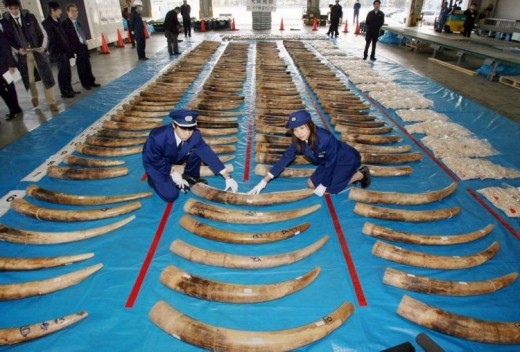 Custom officers display a total of 2.8 tons of ivory on March 1, 2007, a record amount seized in Japan, a top black market destination for elephant tusks.
The U.N.’s Convention on the International Trade of Endangered Species of Fauna and Flora rejected Zambia and Tanzania’s request to sell it’s stockpile of ivory.
(AFP/Getty Images)
.
Custom officers display a total of 2.8 tons of ivory on March 1, 2007, a record amount seized in Japan, a top black market destination for elephant tusks.
The U.N.’s Convention on the International Trade of Endangered Species of Fauna and Flora rejected Zambia and Tanzania’s request to sell it’s stockpile of ivory.
(AFP/Getty Images)
.
‘Zambia and Tanzania’s request to hold a one-off sale for their ivory stockpile, valued of approximately $15 million, were rejected during the U.N.’s Convention on the International Trade of Endangered Species of Fauna and Flora (CITES) annual meeting in Doha. The increase of poaching and illegal ivory sales in both countries in 2009 were the main reasons for the rejection.
Since the ivory trade was banned in 1989, there has been an exemption that allows countries that have proven effective in conservation measures to have a small amount of regulated trade in ivory. Currently, Zambia and Tanzania are forbidden to sell ivory.
“It’s crucial that central and western African nations suppress the brazen poaching, mainly fueled by organized crime and illegal ivory markets openly operating within their borders before any further ivory sales take place,” said Sybille Klenzendorf, managing director of Species Conservation at WWF-U.S. in a press release.
According to a report from the Elephant Trade Information System (ETIS), which keeps track of ivory seizures, there exists a direct relationship between an increase in poaching and poor law enforcement. In the past two years, the number of elephants that were killed as a result of poaching has quadrupled.
Opponents of the ban say that Tanzania ought be allowed to dispose of their ivory stockpile as to avoid spending large sums of money on security and storage.
During the meeting, in which 175 countries participated, some animals were added to the list of protected species. The rise of e-commerce is now believed to be one of the latest and biggest threats to wildlife, as global Internet access has made it increasingly easy to buy and sell illegal wildlife products with little control.
“The transactions kind of come and go and take place before anybody really even knows it, leaving it to the post office to be enforcing this global regime of trade regulation,” Paul Todd, a campaign manager for the International Fund for Animal Welfare (FAW) was reported as saying by ABC news in Australia.
Back in 2005, a FAW investigation reported that in one week alone, over 9,000 live animals or products in five categories of animals were for sale on English-language Web sites, chat rooms and the popular auction site eBay. Some of the live animals found included a gorilla in London, and a Siberian tiger in the U.S. Body parts and products were also commonly found with ivory being common.’
.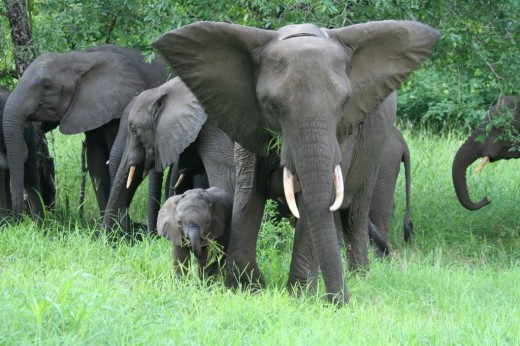
An African Elephant herd
(click photo to enlarge)
Elephants are very intelligent, lifelong loyal and have immense family bonds.
A female elephant listens and watches the photographer intently, with her young close to her side.
An elephant mother will protect her calf to her death.
.
.
 Australia’s big ‘game hunter’, Robert Borsak in Zimbabwe (2008)
Australia’s big ‘game hunter’, Robert Borsak in Zimbabwe (2008)
.

‘Macdonald’s game council thrill killer‘
by Andrew Clennell, State Political Editor, Sydney Morning Herald, 20090721, ^http://www.smh.com.au/environment/conservation/macdonalds-game-council-thrill-killer-20090720-dqui.html].
Robert Borsak (on the NSW Government’s Game Council) went to northern Zimbabwe to hunt elephants. On a two-week trip he killed several, including a bull elephant he shot in the head from a distance of six paces.”My reflexes took over as the rifle fired … he went down, as if in slow motion,” writes Mr Borsak in an article entitled Bulls in the Rain posted on the internet. “It was awesome. He did not know what had hit him.”Back in Australia, Mr Borsak has bagged another prize. The big game hunter and former vice-chairman of the Shooters Party is being paid $342 for each sitting day as chairman of the Game Council of NSW, one of 58 quangos which operate under the Primary Industries Minister, Ian Macdonald. Mr Borsak hopes to run for the Shooters Party at the next election. If successful, he would join a party that now holds the balance of power in the upper house and is holding the Government to ransom after Mr Macdonald failed to negotiate through cabinet the right to shoot in National Parks.It is an example of the kind of interests the embattled Mr Macdonald is accused of helping to protect in some of the committees and statutory bodies he oversees.Mr Borsak is being paid $342 a sitting day for his part in regulating hunting in this state. Conservationists say the Game Council’s only purpose is to win the Shooters Party votes.Last week there were revelations the minister spent close to $150,000 on a wine industry council he set up, chaired by his friend Greg Jones; and that the minister had put other Labor identities – such as union boss Russ Collison and former Labor MPs – on quangos.The Herald learned yesterday Mr Macdonald appointed a friend of 25 years, John Gerathy, the law partner of former Labor deputy prime minister Lionel Bowen, to the wine council and the Homebush motor racing board.Mr Macdonald is under siege. Yesterday the acting Opposition Leader, Andrew Stoner, referred him to the Independent Commission Against Corruption over claims he gave special treatment to another Labor mate, the former construction union president John Maitland, over granting an exploratory licence for a Hunter Valley mine.
The Premier, Nathan Rees, refused to comment yesterday when asked if the Left assistant secretary Luke Foley, who wants Mr Macdonald’s upper house seat, would be a better cabinet minister than Mr Macdonald.
As for Mr Borsak, he was resentful yesterday that he might be included in a story to do with Mr Macdonald.
The Game Council has received more than $11 million in government funding since 2002 and $3.5 million last year, despite promises from Mr Macdonald it would end up being self-funded.
Mr Borsak said the Game Council was set up in 2002, before Mr Macdonald was minister, and should not be lumped in with other committees as it was a statutory body. He said he was a businessman who received “a grand total of $1368 for last financial year for about 60 days’ work for the council”.
“Why would there be a conflict of interest,” Mr Borsak said, when asked whether his involvement in the Shooters Party might mean he should not be involved in the Game Council. He said of the Zimbabwe hunt: “The fact is I do it [the hunt] and I do it legally and I did it as part of licensed conservation programs. The … tusks belong to the Zimbabwean Government.”
The executive director of the Nature Conservation Council, Cate Faehrmann, said it was time the Game Council’s “activities were thoroughly scrutinised”.
Mr Maddonald’s “aggressive support of the establishment of game reserves and hunting in National Parks is all the more insidious when you realise at least one of the people behind this push likes to kill elephants in his spare time,” she said.
“By pumping millions of dollars into the Game Council, Minister Macdonald is sanctioning bloodsports.”
Mr Stoner called for Mr Macdonald to be sacked. “It seems every day there are more doubts raised about Ian Macdonald … There will be more, so Nathan Rees should do the right thing and sack this minister.”
.
.
‘The cruelty and corruption of the elephant hunt’
[Source: Sydney Morning Herald, following letters to the editor, 20090722, ^http://www.smh.com.au/environment/conservation/the-cruelty-and-corruption-of-the-elephant-hunt-20090722-dtb3.html].
Letters to the Editor
‘I began hunting as soon as I was old enough to use a rifle. But the photo of Robert Borsak gloating over the body of an elephant he shot in Zimbabwe fills me with disgust (“Macdonald’s game council thrill killer”, July 21).Zimbabwe is one of few African countries to allow this practice. People typically pay about $US20,000-$26,000 ($25,000-$32,000) for this privilege. Bulls are more expensive, presumably because of their tusks. Where does this money go? Here is a hint.Advertisement: Story continues belowThe BBC reported a decade ago that the government of Robert Mugabe earned US$2.5 million by selling 20 tonnes of elephant tusks, although the ivory trade had been banned. Zimbabwe lies about its elephant population to get around the ban. This practice is probably greater today.As the economy collapsed, the Zimbabwean Army, the key to Mugabe’s survival, cancelled all contracts to supply beef. The Zimbabwean Conservation Task Force reports soldiers have complained the only meat they are given is from elephants. So in addition to the immense pleasure Borsak apparently feels in the senseless destruction of a great creature, he can also take pride in doing his bit to keep Africa’s worst despot in power.’~ Don Moore, Lilyfield
.
.
‘I loved the juxtaposition of the stories about Robert Borsak, and Sining Wang and Edward Liew (“Don’t have a cow man – it’s got rights”, July 21). Thank heavens for the next generation of intelligent and compassionate thinkers. I hope it is only a matter of time before Wang and Liew can flex their legal muscles against thug shooters such as Borsak. The sooner they are banned from indulging in their cruel and destructive hobbies, the better.’~ Belinda Connolly, Caringbah.
.
‘It has been said that people get the politicians they deserve.What does it say about the people of NSW when there is a danger of Robert Borsak standing for a seat in Parliament – a man who admits to the thrill of downing a bull elephant “from a distance of six paces”?’Jill Klopfer, Wahroonga.
.
‘So Robert Borsak killed elephants in Zimbabwe “as part of licensed conservation programs”.The corrupt Zimbabwean Government and conservation are complete strangers, as anyone who has anything to do with trying to save what is left of Zimbabwe’s wildlife can tell you.’Colleen Riga, Potts Point.
.
‘Robert Borsak says “the tusks belong to the Zimbabwean Government”. No – the tusks belong to the elephant.’Jean-Marc Russ, Darlinghurst.
.
‘It comes as no surprise to learn of Ian Macdonald’s patronage of hunters. The minister has shown scant regard for the welfare of animals, as those of us working in animal charities can attest. His $3.5 million for the Game Council compares with the $533,000 in funding he announced in April to be split between the RSPCA, Animal Welfare League, WIRES, Cat Protection Society and the Domestic Animal Birth Control Co-operative Society.The Government opposes Clover Moore’s bill to reduce the suffering of cats and dogs by regulating their sale, and even pleas for an inquiry into the welfare of companion animals have been rejected. A minister who gives priority to working with a hunter who describes shooting an elephant as awesome is hardly likely to care that tens of thousands of cats and dogs are killed annually on his watch.’Kristina Vesk chief executive, Cat Protection Society of NSW, Newtown
.
– end of article –
